Sarah Sundin's Blog, page 206
September 29, 2018
Today in World War II History—Sept. 29, 1943
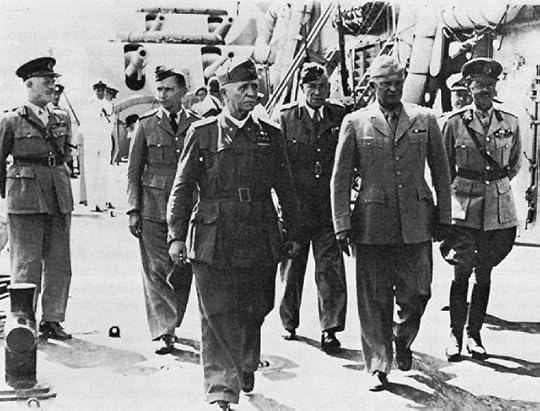
Italian Premier Pietro Badoglio and Gen. Dwight Eisenhower on battleship HMS Nelson for Italian surrender to Allies at Malta, 29 September 1943 (US Army Center of Military History)
75 Years Ago—Sept. 29, 1943: Gen. Dwight Eisenhower and Italian premier Pietro Badoglio sign official Italian armistice on battleship HMS Nelson at Malta.
US 100th Infantry Battalion (Japanese-Americans primarily from Hawaii) is attached to US Fifth Army in Italy.
September 28, 2018
Today in World War II History—Sept. 28, 1943

Georg Duckwitz, 1960 (German Federal Archive: B 145 Bild-F008672-0027)
75 Years Ago—Sept. 28, 1943: Roman Jews pay ransom of 50 kg of gold to Nazis with help from the Vatican; however, it will not be honored.
German diplomat Georg Duckwitz, stationed in Copenhagen, Denmark, learns of Gestapo plan to round up Danish Jews; he warns Danish Resistance at great personal risk, allowing Danes to save almost all of Denmark’s Jews.
September 27, 2018
Today in World War II History—Sept. 27, 1943
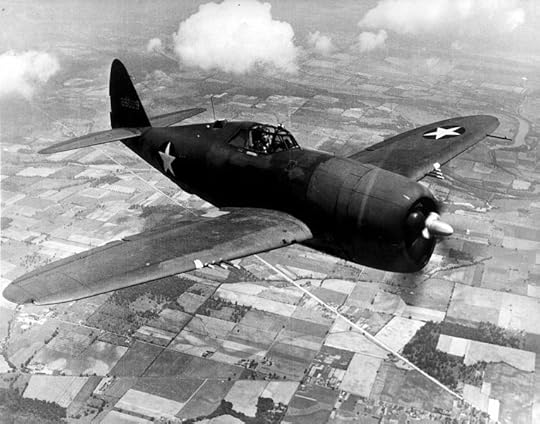
Republic P-47D Thunderbolt (US Air Force photo)
75 Years Ago—Sept. 27, 1943: US 8th Air Force P-47 Thunderbolt fighters escort bombers all the way to targets in Germany for the first time.
Soviets take Temyruk, Russia, last German-held port on the Black Sea.
On the night of Sept. 26-27, Australian commandos enter Singapore Harbor on a fishing boat and sink or damage 7 Japanese ships with limpet mines.
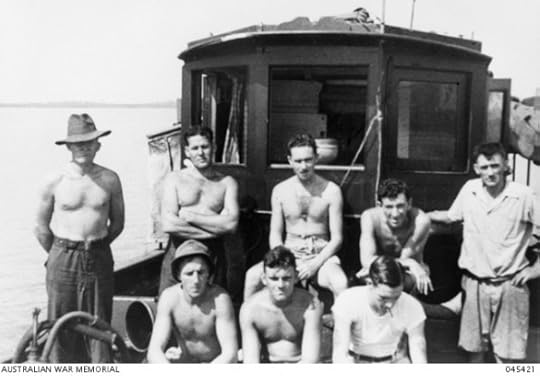
Australian commandos and crew of MV Krait en route to Singapore, September 1943 (Australian War Memorial: 045421)
September 26, 2018
Today in World War II History—Sept. 26, 1943

Wreckage in the dock area of Naples, Italy, caused by the Germans before they left the city, 1943 (US Army Center of Military History)
75 Years Ago—Sept. 26, 1943: As the Allies advance north in Italy, an anti-Fascist uprising begins in Naples; 300 civilians will be killed in the next week.
September 25, 2018
Hospitalization in World War II – Evacuation of the Wounded
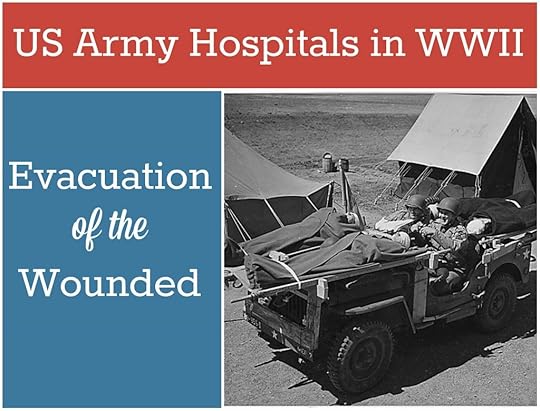
Photo: Jeep ambulance at Camp Carson, CO, 24 Apr 1943 (US National Archives)
Unlike the US Fifth Army, Hutch crossed the Volturno River backward. While the Allies crossed under machine-gun fire eleven days earlier, Hutch rode in a jeep, turned in the front seat to face little Lucia. Her litter was strapped across the backseat, while two more litters were strapped on the hood.
A furrow raced up Lucia’s forehead, and she clutched her doll even tighter.
Time for Hutch’s treat. “I have a gift for you. For Lucia.” (On Distant Shores, p. 194)
In my novel On Distant Shores, the hero serves as a pharmacist in an evacuation hospital and the heroine serves as a flight nurse. I’m running a series on hospitalization in World War II. Earlier I discussed the chain of evacuation, then I discussed mobile and fixed hospitals in more detail, and today I’ll cover evacuation of the wounded.
Manual Transport
On the battleground, medics or fellow soldiers could manually carry a wounded man further to the rear for aid. Methods included the supporting carry (walking side-by-side), the arms carry, the saddleback carry (piggy-back), and the fireman’s carry.
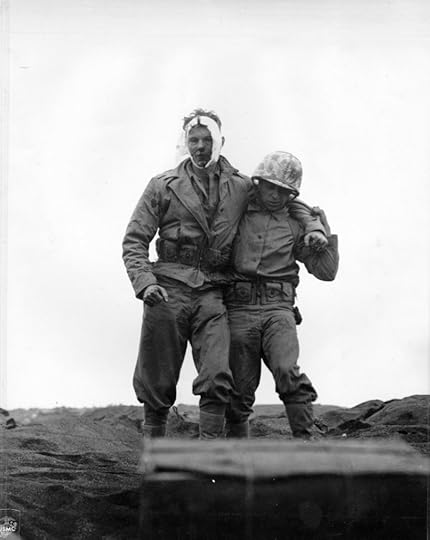
Wounded US Marine being helped by a comrade, Iwo Jima, 20 Feb 1945 (US Marine Corps photo)
Litter Transport
American litters were made of canvas stretched over aluminum or wood poles with stirrup-shaped feet to keep them off the ground. A litter could be carried by two people, but a litter squad consisted of four men, to rotate if traveling long distances and to assist over obstacles. Ideally, litter transport was only used for short distances, but in mountainous or forested or swampy terrain, litter transport was the only available means. Mules were often used in the Mediterranean Theater to carry litters in rocky, mountainous terrain.
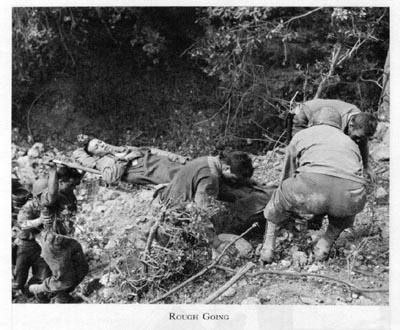
Litter-bearers in Italy’s mountains, WWII (US Army Medical Dept.)
Motor Transport
Ambulances were used to transport patients, usually from an aid, clearing, or collecting station to a field hospital, or for transport further to the rear. Ambulances could carry seven seated patients or four patients on litters.
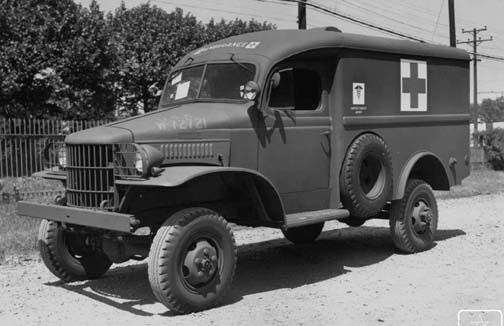
Dodge WC9 1/2 ton ambulance, 15 May 1941 (US National Archives)
Jeeps were often used, both on the battleground and to transport further to the rear. Rugged and maneuverable, jeeps could cover terrain inaccessible to ambulances. With litter brackets, a jeep could carry two or three patients. Armored divisions also used light tanks to transport their wounded.
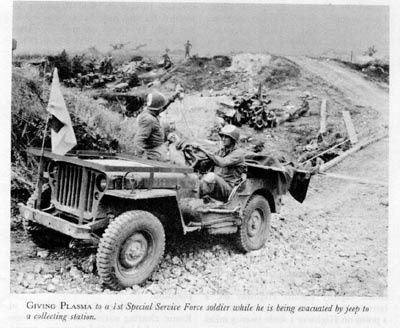
US medics administer plasma to a patient in a jeep ambulance, Italy, 1944 (US Army Medical Dept.)
Water Transport
During an amphibious landing, the best way to handle the wounded was to send them back on departing landing craft, which carried them to transports or hospital ships off-shore. Patients could be removed from danger and transported quickly to get needed care.
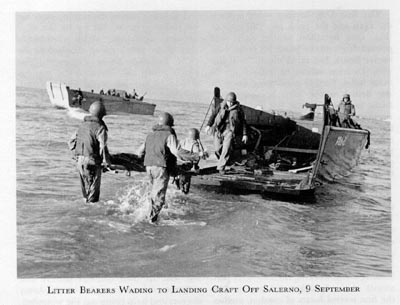
Wounded American soldiers being evacuated by landing craft (LCVP) off Salerno, Italy, 9 September 1943. (US Army Medical Dept.)
Hospital ships were used offshore after an invasion to care for the wounded before field and evacuation hospitals could be set up. They also transported patients who needed long-term care to general hospitals further to the rear. Another use of hospital ships was to transport to the US any patients who needed long-term convalescent care or those who qualified for a medical discharge. They carried several hundred patients and delivered full medical care, but transport took a long time and carried the danger of enemy attack at sea, even when marked with the Red Cross.
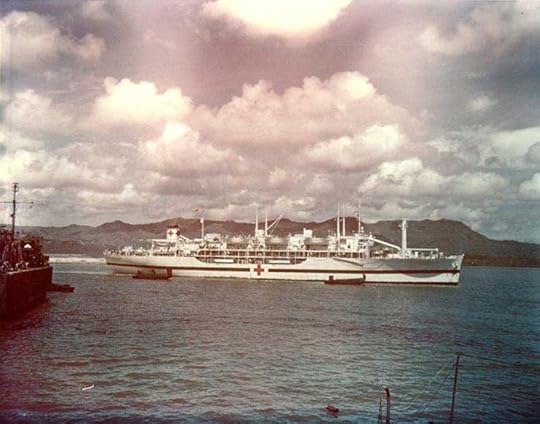
Hospital ship USS Tranquillity arriving at Guam with survivors of sinking of USS Indianapolis, 8 Aug 1945. (US National Archives)
Rail Transport
Hospital trains were used within theaters of operation to transport patients from one hospital to another. They were used in the continental US, Britain, continental Europe, India, and North Africa. They could carry several hundred patients and provide excellent medical care.
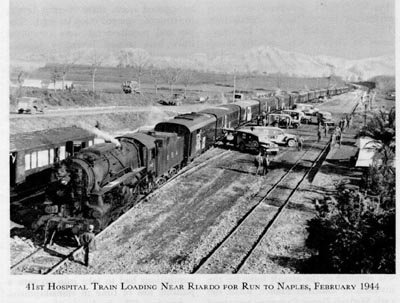
US 41st Hospital Train running from the Italian front to the Army hospital complex in Naples, February 1944 (US Army Medical Dept.)
Air Transport
Medical air evacuation was new and revolutionary, but by the end of the war, it proved successful. Planes can traverse inhospitable terrain or dangerous seas—and quickly. C-47 cargo planes carried 18-24 litter patients or a higher number of ambulatory patients. A team consisting of a flight nurse and a surgical technician cared for the patients in flight. The larger C-54 cargo plane was used for trans-oceanic evacuation. Danger still existed, both from the inherent risks of flight and also because the planes carried cargo, couldn’t be marked with the Red Cross, and were legitimate military targets.

Lt. Katye Swope of the 802nd Medical Air Evacuation Transport Squadron checks patients being evacuated from Agrigento, Sicily to North Africa for further medical treatment, 25 July 1943. (US Air Force photo)
Resources
Office of the Surgeon General. Medical Field Manual: Transportation of the Sick and Wounded. Washington, DC: US Government Printing Office, Feb. 21, 1941. Please note the date—some of the material, especially about air evacuation, became quickly outdated.
For better information on air evacuation, please see:
Links, Mae Mills & Coleman, Hubert A. Medical Support of the Army Air Forces in World War II. Washington, D.C.: Office of the Surgeon General, USAF, 1955.
Today in World War II History—Sept. 25, 1943
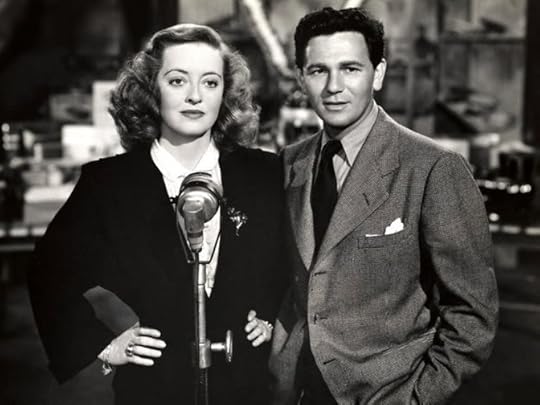
Bette Davis & John Garfield, founders of the Hollywood Canteen, 1942 (public domain via Wikipedia)
75 Years Ago—Sept. 25, 1943: Soviets take Smolensk and Roslavl, Russia.
Movie premiere of musical Thank Your Lucky Stars; the all-star cast donates their salaries to the Hollywood Canteen.
September 24, 2018
Today in World War II History—Sept. 24, 1943
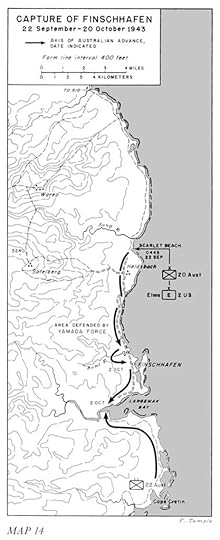
Map of the Australian offensive on Finschhafen, New Guinea, 22 Sept-20 Oct 1943 (US Army Center of Military History)
75 Years Ago—Sept. 24, 1943: Australians cross Bumi River in New Guinea on way to Finschhafen.
September 23, 2018
Today in World War II History—Sept. 23, 1943
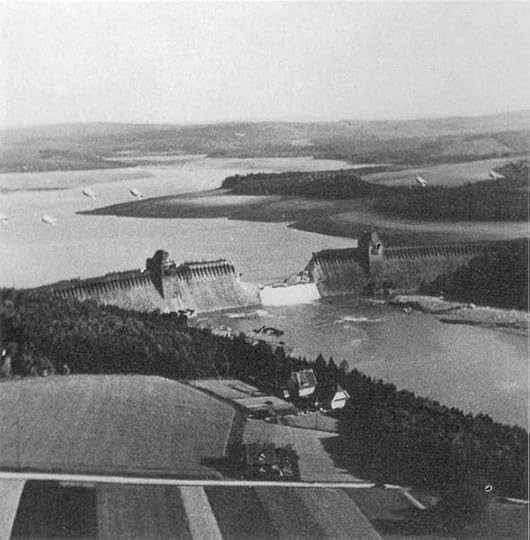
Möhne Dam in Germany after the RAF Dambuster Raid, 18 May 1943 (British Government photo)
75 Years Ago—Sept. 23, 1943: Germans finish repairs to Möhne Dam in Ruhr, breached in RAF Dambusters raid in May.
In Allied convoy ON-202 off Greenland, German U-boats sink 5 ships; in this convoy, 12 ships have been sunk by the German’s new T-5 acoustic torpedoes.
September 22, 2018
Today in World War II History—Sept. 22, 1943

Pvt. Paul Oglesby of US 30th Infantry Regiment in a damaged Catholic Church at Acerno, Italy, 23 September 1943 (US National Archives)
75 Years Ago—Sept. 22, 1943: Mussolini proclaims Repubblica Sociale Italiana, based in German-occupied northern Italy.
In Italy, US Fifth Army takes Acerno and Oliveto.
At Alta Fjord in Norway, British midget subs damage German battleship Tirpitz with mines; it will be out of commission until April 1944.
September 21, 2018
Today in World War II History—Sept. 21, 1943
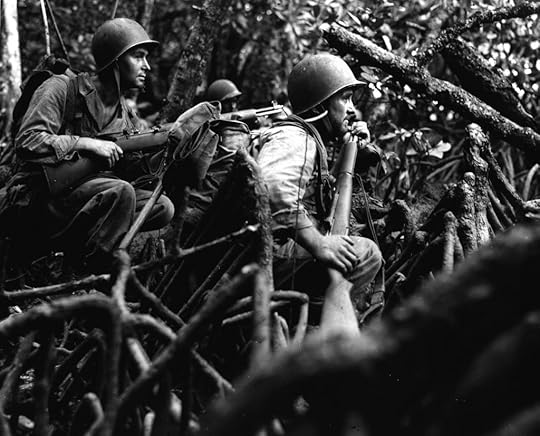
US Army infantrymen fighting in the jungles of Vella Lavella, Solomon Islands, 13 September 1943 (US Army Signal Corps photo)
75 Years Ago—Sept. 21, 1943: US secures Baanga, Arundel, and Wana Wana in the Solomon Islands.
Soviets cross Dnieper River south of Kiev, Ukraine.



